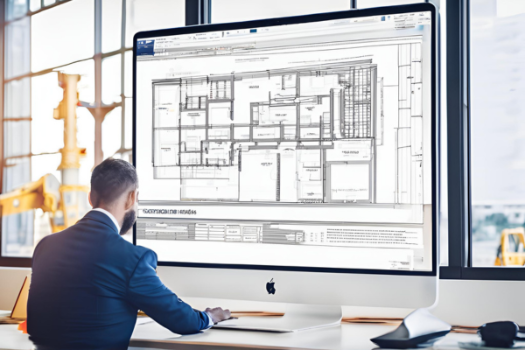.png)
Tackling Construction Challenges with BIM: A Path to Success!
Introduction
The construction industry faces numerous challenges that impact project success. From rising costs to frequent delays, these issues can disrupt timelines and strain budgets. Tackling these problems requires innovative solutions, and Building Information Modeling (BIM) has emerged as a game-changer in this space.
BIM revolutionizes how projects are planned, executed, and managed. By integrating digital tools, it allows teams to collaborate seamlessly, visualize outcomes, and address problems before they occur. This article explores how BIM tackles critical construction challenges, including cost overruns, poor communication, and safety concerns.
We’ll dive into BIM’s role in improving collaboration, enhancing project visualization, and streamlining schedules. You’ll learn how it supports better decision-making and ensures quality while reducing risks. Whether you're facing complex designs or tight deadlines, BIM provides a clear path to success, transforming how the industry works today.
Understanding Construction Challenges
Modern construction projects are more complex than ever before. Designs are intricate, timelines are tight, and stakeholders demand precision. Managing these complexities requires clear planning and coordination. Without the right tools, teams often struggle to keep everything aligned, leading to confusion and delays.

Budget overruns are another common issue. Construction costs can quickly spiral out of control due to unexpected expenses or poor planning. When budgets are exceeded, project viability is put at risk. Stakeholders face difficult decisions, often compromising quality or scope to stay within financial limits.
Time delays add to these challenges. Projects can be delayed by weather, supply chain issues, or miscommunication among teams. Each delay increases costs and strains relationships with clients. Sticking to schedules becomes a major challenge in such a dynamic environment.
Maintaining quality and safety is also a pressing concern. As projects grow in scale, ensuring every aspect meets high standards becomes harder. Safety risks, if overlooked, can lead to accidents, downtime, and added expenses. Balancing quality and safety with speed is no easy task.
Understanding these challenges is the first step toward overcoming them. Addressing them requires innovative solutions, like BIM, to simplify processes and deliver successful results.
What is BIM?
Building Information Modeling, or BIM, is a digital approach to construction planning and management. It creates a detailed representation of a building’s physical and functional characteristics. By using BIM, teams can visualize a project in its entirety before any work begins. This helps identify potential issues early, saving time and resources.

The core of BIM lies in its 3D modeling capabilities. These models provide a realistic view of the project, helping stakeholders understand the design and layout. Beyond visualization, BIM incorporates powerful data management tools. It organizes and stores critical information, such as materials, costs, and timelines, in one accessible place.
Collaboration is another key component of BIM. It allows architects, engineers, and contractors to work together in real-time. Changes made by one team are instantly visible to others, reducing miscommunication and errors. With these features, BIM simplifies complex projects and improves outcomes.
How BIM Addresses Construction Challenges
Enhanced Collaboration and Communication
BIM acts as a centralized hub for project information, bringing all data into one easily accessible location. Architects, engineers, and contractors can view the same data, reducing the chance of miscommunication. This ensures everyone works with the same details, avoiding errors caused by fragmented information.
Real-time updates further enhance communication. When changes are made to designs, schedules, or budgets, they are instantly visible to all stakeholders. This transparency ensures teams can quickly adapt and make informed decisions. The result is smoother coordination and fewer delays.
Improved Project Visualization
BIM’s 3D modeling capabilities provide a clear picture of the entire project. This helps teams and clients better understand the design, materials, and layout. Visual clarity allows for better planning and reduces misunderstandings about project requirements.
Virtual walkthroughs let teams explore the project in a digital environment. They can identify potential design or construction issues before work begins. By catching these problems early, teams save time and avoid costly rework, ensuring a more efficient process.

Accurate Cost Estimation and Budget Management
BIM simplifies cost estimation by automating quantity takeoffs. These precise calculations help contractors understand material needs and avoid over-ordering or shortages. This accuracy reduces unnecessary expenses and supports better budget planning.
Additionally, BIM integrates budgeting tools directly into its platform. Teams can monitor spending in real time and compare it to the planned budget. This visibility ensures financial control, helping projects stay on track and avoid overspending.
Efficient Scheduling and Time Management
BIM introduces 4D scheduling by linking time-related data to the 3D model. Teams can visualize the construction sequence and better understand how tasks align with the timeline. This integration improves planning and execution.
By analyzing the schedule through BIM, teams can optimize construction sequences to save time. Delays caused by overlapping tasks or resource conflicts are reduced. With a clearer timeline, teams can work more efficiently and meet deadlines.
Quality Control and Safety Enhancement
BIM’s clash detection tools identify conflicts in designs before construction begins. This prevents costly errors on-site and ensures smoother project execution.
Safety planning is also improved through BIM. Teams can simulate construction scenarios and identify risks, enabling proactive safety measures. This reduces accidents and keeps workers protected, fostering a safer work environment.
Implementing BIM: Best Practices
Training and education are essential for successful BIM implementation. Team members need to understand how to use BIM tools effectively and apply its methodologies in real-world scenarios. Investing in training programs helps build confidence and ensures the team can fully leverage BIM's potential.

Integrating BIM into existing workflows requires careful planning. Start by analyzing current processes to identify areas where BIM can add value. Gradual adoption, with pilot projects, allows teams to adapt without overwhelming them. Clear communication and support during this phase minimize disruptions and foster a smoother transition.
Continuous improvement is key to maximizing BIM’s benefits. Regularly evaluate BIM practices to identify what’s working and what needs adjustment. Encourage feedback from teams to refine workflows and stay ahead of industry advancements. By consistently updating practices and adopting new features, businesses can ensure long-term success with BIM.
Conclusion
BIM is a powerful tool that transforms how construction projects are planned and executed. It tackles key challenges such as poor communication, cost overruns, delays, and safety risks. With centralized information, accurate cost management, and improved collaboration, BIM ensures projects are more efficient and successful.
Now is the time for construction professionals to embrace BIM. By adopting this innovative approach, you can enhance project outcomes, reduce risks, and stay competitive in an evolving industry. Take the first step toward smarter construction and explore how BIM can drive your projects to success.